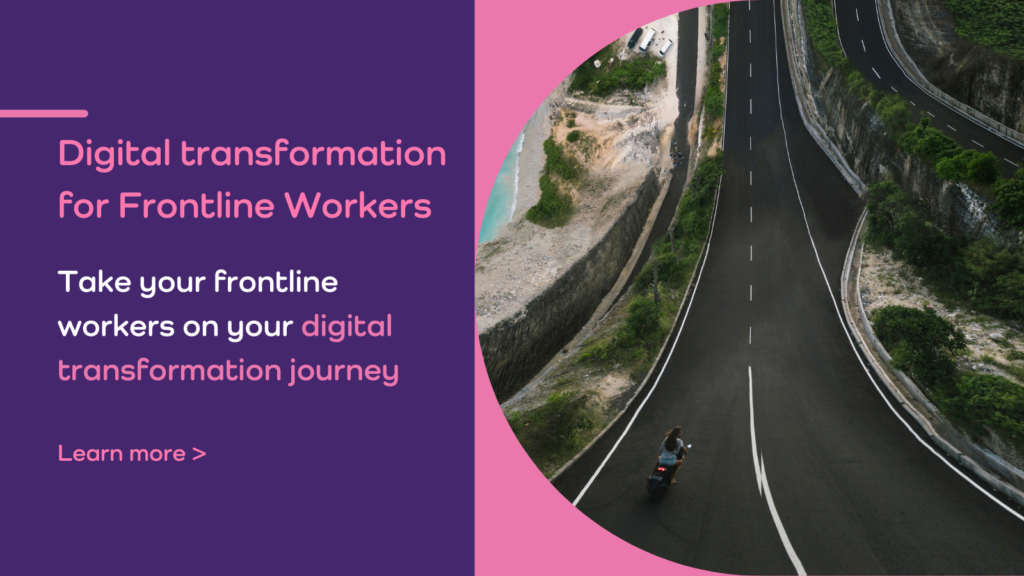Frontline workers have long been the neglected when it comes to digital transformation. As a result, shadow IT has become a significant challenge for IT teams. A Microsoft study found that 54% of IT executives suspect that frontline workers use a variety of unsanctioned shadow IT to work effectively.
Other research explains why. A Forrester study found that 77% of frontline workers say they do not have access to the technology they need to be productive. This is especially common amongst hourly and contract workers, who make up most of the frontline workforce. Technology investments are often focused on salaried staff with frontline workers overlooked.
Learn more about technology for frontline workers here >
Shadow IT is a security and compliance risk
Many IT teams cite security and compliance as a reason for limiting frontline workers’ access to corporate systems and data. With a workforce operating in public spaces or offsite – regarded as deskless, mobile or untethered – providing access is often viewed as too big a security and data protection risk.
But in our opinion, the risk that shadow IT poses is just as much a challenge. A tech-savvy workforce, that wants tools to help them work more efficiently, will find workarounds if you don’t provide them. If frontline workers don’t have access to the right technology to communicate with teammates, check their shift schedules, record and look up data, or plan their day, they will introduce their own technology. Shadow IT in the form of consumer technology, from devices to apps, introduces new levels of risk precisely because it is unknown to IT.
Despite shadow IT’s risks, it is hard to criticise when people are just trying to get their jobs done efficiently. Most frontline workers have no idea that the apps they use and data they handle, could be breaching corporate policies and data protection regulations. As the backbone of many organisations, surely it’s time to bring frontline workers on your digital transformation journey and ensure they are secure and compliant?
Digital transformation and frontline workers
In some organisations, shadow IT can be part of a digital transformation journey for frontline workers. After all, they understand what they need to work productivity and may have already identified solutions that can be integrated into the corporate IT environment.
As part of the discovery and planning stage of any digital transformation project, reviewing the existing IT environment and uncovering any shadow IT is an important part of understanding what works and what doesn’t.
However, consumer technology is often not secure enough to be deployed as a workplace solution or may not integrate seamlessly with other systems, creating data siloes. Besides, technology companies have spotted that frontline workers have been underserved, and there are many solutions now available that will deliver the benefits desired, securely and compliantly.
Putting frontline workers first
User experience must be at the heart of digital transformation for frontline workers. It is essential to win over the hearts and minds of your frontline workforce before enforcing a technology change, even when it’s designed to improve their working day.
Frontline workers have unique technology requirements and challenges. Although they frequently get confused with remote workers, they are distinctly different. Over the last 20 months we’ve often heard people say that “we’re all frontline workers now”, but remote workers (especially those that are working from home) generally have a desk, WiFi and a laptop or desktop computer.
The majority of frontline workers for most of their working day, do not have a desk or access to a PC. Instead, they use a mobile device and may routinely face connectivity issues, using mobile data or public WiFi to access the apps they need.
Therefore, a digital transformation project that takes frontline workers on the journey too, must be designed around the user experience for those in the field, working on shop or factory floors, in healthcare settings or otherwise deskless and untethered.
For example, many company intranets deliver a poor experience on a mobile phone. That’s generally because they’ve been designed for desktop use by desk-based teams, and even a mobile app version can be clunky. No wonder that frontline workers embrace lightweight consumer apps that have been developed for the mobile user.
Focus on user experience
So, providing technology for frontline workers is not just a case of giving them secure access to existing corporate systems and apps. It’s about making sure the technology delivers the best possible user experience, to boost user adoption and remove the need for shadow IT.
We do this by getting an in-depth understanding of our customers’ end users during the discovery and planning stage of a digital transformation project. Our desk based consultants put themselves in their shoes, whether that’s a mobile engineer servicing equipment in a WiFi dead zone or a customer services assistant on the shop floor in a retail park.
Having understood their technological challenges and requirements we can then identify the solutions that deliver real value to the frontline workforce, so they get the best possible experience from their technology.







